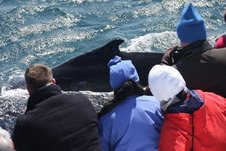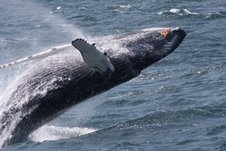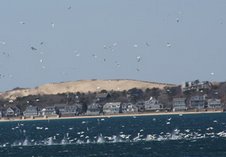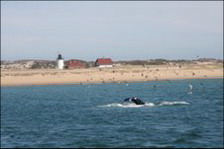Dolphin Fleet Naturalist Notebook 11 April to 17 April 2009
After a long winter it is finally time to board the Dolphin VIII and head into Cape Cod Bay to see the whales we have been watching from shore since March. Saturday dawns cold and wet- but that did not deter us from our first whale watch of the 2009 season. Our first sighting was of finback whales and over 250 Atlantic white-sided dolphins. Further in the Bay we sighted our first humpback whale, a large female named Mural who returned last year with a calf. In the same area were smaller humpback whales. Only two, Tapioca and Eraser, were individuals that we had sighted in previous years. It seems as if spring brings an abundance of small humpback whales that remain unnamed until the following year.
Sunday, Monday and Tuesday were bright, breezy and cold- more winter than springtime weather. Once again we saw small humpback whales- one identified as Palette’s calf of 2007- as well as finback whales and dolphins close to Provincetown’s shore. Despite choppy seas, we sighted a small harbor porpoise, the smallest of the whales in our waters and a species occurring more frequently during spring. Further in the Bay we saw a large splash. A humpback whale was breaching– literally jumping out of the water head first- a behavior we enjoy watching but know little about.
A humpback whale breaches
As we moved towards the coast, our attention was drawn to a flurry of activity- Northern gannets plunge diving into Bay. At first we saw only splashes and then, hovering birds plunging into the water. Mature gannets are brilliant white with black wing-tips, yellow coloration on their head and blue eyes. Their wing-span is about 6’ although they appear smaller when viewed from a 100’ vessel. Hovering high in the air the gannets dive directly toward the water, folding their wings just before plunging. They can dive up to 30’.
Plunge-diving gannets
On our way back to Provincetown, a small humpback was sighted in the harbor. The humpback approached us as we slowly moved to the dock and followed us to the breakwater!
On Wednesday we sighted a harbor seal basking in the sun on Long Point- the last tip of land in Massachusetts. Harbor and gray seals are becoming more and more common along our beaches this time of year. We ventured towards Race Point, passing Herring Cove Beach, where a small fishing village and salt works, called “Helltown,” was established in the 1800’s. Salvagers, according to local legend called mooncussers, sold the remnants of shipwrecks found on beaches around Race Point, the northern most tip of land in Provincetown.
A humpback flukes near Race Point
Race Point was named for its powerful crosscurrent, known as a ‘race’. It is here that the flow of the Atlantic meets the countercurrent of Cape Cod Bay, treacherous bars lurk beneath the water’s surface where hundreds of ships met their fate. The HMS Somerset, the most notable shipwreck near Race Point, is immortalized in Henry Wadsworth Longfellow’s poem, “Paul Revere’s Ride.” Finback whales, small humpback whales and dolphins moved through the waters of the rip with gannets and gulls hovering above. We identify 3 of the small whales as calves of previous years: Roswell’s calf of 2007 and Twister’s calf of 2008.
Roswell’s 2007 Calf
Thursday and Friday remain bright and cold. The whales, dolphins, porpoise and birds remain abundant in the Bay. We are grateful they are so close to shore as the Dolphin Fleet abides by a Federal rule that all vessels over 65’ move at speeds no faster than 10 knots (just over 11 miles per hour!). The rule was put in effect to help protect the critically endangered North Atlantic right whale, abundant in our waters this time of the year. So far, we have not sighted right whales, much to the dismay of the passengers. However, once sighted, all vessels must not approach within 500 yards of these rare animals.
Birds sighted: Black-backed, herring, laughing and glaucous gulls; common loon; common eider; double-crested cormorant; white-winged scoter; red-breasted merganser; Northern gannets; razorbills; black ducks










